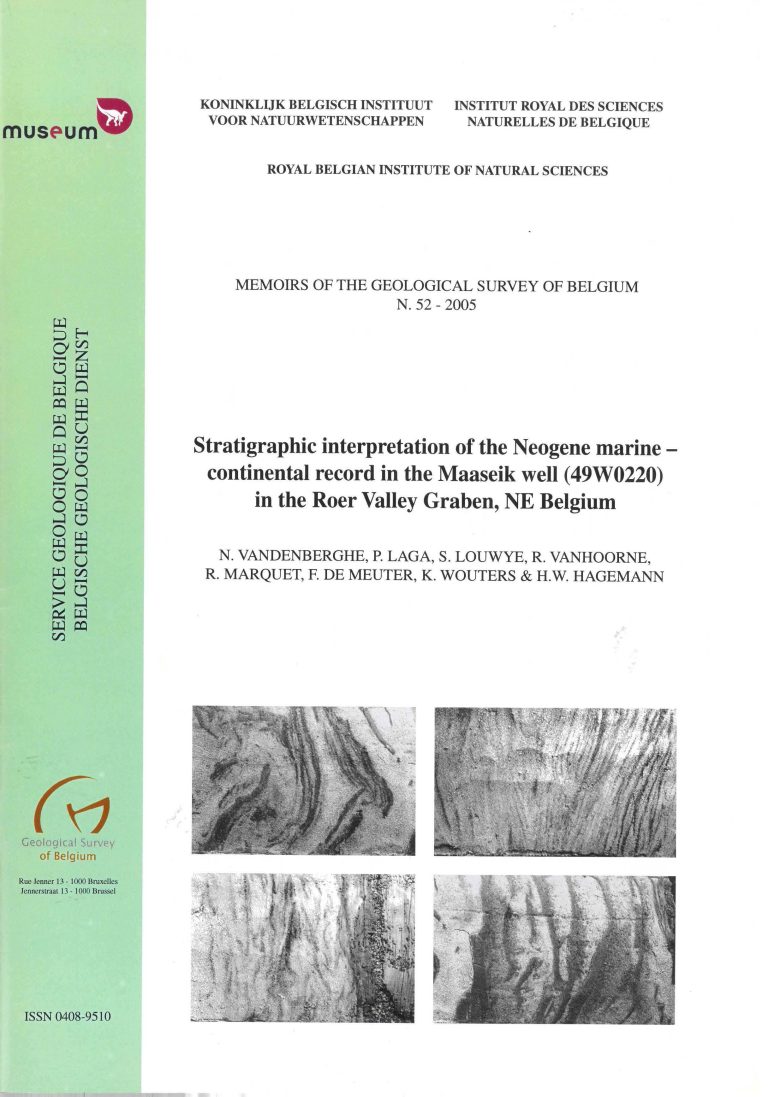
Publication details:
The printed version of the Memoirs Vol. 52 is available for sale at the GSB. For ordering, please contact gsb@naturalsciences.be
A 302 m deep, cored reconnaissance well was drilled in 1980, at Jagersborg to the northwest of Maaseik
(49W0220). & e borehole is located north of the Feldbiss fault system, in the Rur Valley Graben. The top of the section consists of Saalian to Pleni-Weichselian Meuse gravels capped by loam. The section between 22 and 193 m is identifi ed as the Kieseloolith Formation, consisting mainly of quartzic sands with the intercalation of four lignite and clay intervals. Lithological characteristics and geophysical well logs allow the traditional identification of the Waubach sands and gravels at the base of the Kieseloolith Formation, overlain by the Pey sands between two lignite and clay levels which are interpreted as Brunssum clay; using the same approach,
the sands above the upper Brunssum clay are interpreted as the Schinveld/Jagersborg sands. & e palynology, however, suggests a Pliocene age, Reuverian, for the entire quartz sand unit although also a Brunssum age could be accorded to the quartz sand below 90 m depth. Two palynozones occur with a boundary around 57.6 m. & e top of the lower palynozone A, between 57.6 and 87.5 m, has a similar composition as the Mol sand lignites occurring to the west, outside the Rur Valley Graben. & e upper palynozone B between 57.6 m and the top of the sands characterizes the Reuverian C and the clay layers present in this section are consequently interpreted as Reuver clay. & e palynozone A represents a landscape covered by dense forest in contrast to the upper palynozone B during which the clearance of the woods had already started, the forest became less dense and enclosed mires more extensive. & e top of the Kieseloolith Formation marks the transition to the Praetiglian. All lignites show a rank between the brown coals in the Lower-Rhine exploitations and peats. The interval between 193 and 198 m is a yellow quartzic, mica-containing marine sand of uncertain stratigraphic position; it might correspond to the Syltian, an uppermost Miocene regional North-Sea stage. The green glauconitic sands between 198 and 302 m are identifi ed as the Breda Formation and can be further subdivided based on grain size and glauconite content. Dinofl agellates and mollusc fragments allow the identification of a lower part between 302 and about 273 m that is biostratigraphically similar to the upper part of the Antwerpen Member and Zonderschot Member of the Berchem Formation to the west. It is considered as Middle Serravallian in age based on dinoflagellates. An upper part between about 235 and 198 m is biostratigraphically equivalent to the Deurne and Dessel Members of the Diest Formation, based on dinoflagellates, molluscs, benthic foraminifera and ostracods. The age of this upper part is Tortonian. The interval between these lower and upper parts of the Breda Formation has no facies equivalents in the Campine basin to the west.
Key words: palynology, dinoflagellates, molluscs, benthic foraminifera, ostracods.